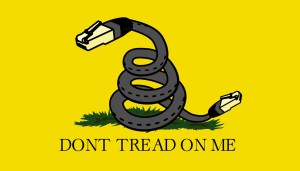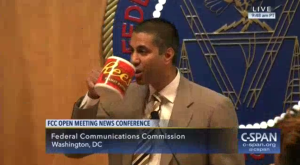The Congressional Review Act & The Internet: How The FCC Might Get Burned By The Very Same Act It Used To Unhinge Privacy Rules For Broadband
The net neutrality vote at the FCC played out as many predicted. And I am not here to talk Title II, common carriers, and the depressing fact that judicial review of administrative actions are often limited.
Today, I wanted to talk about another interesting Act, the Congressional Review Act, that, if used properly, could effectively nullify the FCC’s anti-net neutrality vote. And, coincidentally, it is the very same Act that helped to kill the consumer-friendly privacy rules for Web users passed under the former FCC chairman.
First though, lets’ talk about those privacy rules, which were tragically nullified even before they were to take effect….
As we well know, Broadband companies like Verizon and Comcast are in a non-stop race to extract and analyze web customer information, including our app usage, browsing habits, and location information. Now, no matter what side of the privacy spectrum you fall on, we are all aware that companies like Google and Facebook already make use of much this data. And, certainly, privacy actions have been brought against those companies in various forms through the years.
The former FCC chairman, Tom Wheeler, helped pass a new set of internet privacy rules in October 2016 which was intended to require broadband Internet Service Providers (ISPs) to protect the privacy of their customers. The rule basically stated that home Internet and mobile broadband providers must get consumers’ opt-in consent before selling or sharing and web history, usage, and other private information with advertisers and other companies. The rules helped to ensure broadband customers have “meaningful choice, greater transparency and strong security protections for their personal information collected by ISPs.”
And privacy and consumer protection advocates cheered! The new rules were scheduled to go into effect this December.
And then we had a shift in the administration.
And then Ajit Pai, a former Verizon lawyer, with his big mug, took the FCC Chairman position.
And then a little-known, little used law suddenly reared its head, and these new internet privacy rules were repealed even before they took effect.
And, on top of that, the FCC is prohibited from proposing similar privacy regulations ever again. Ever. Again.
How? What rule could be so powerful to upend a legal administrative process? And employ a permanent preemptive strike against any similar future law?
Enter the Congressional Review Act (“CRA”).
The CRA requires federal agencies, like the FCC, to report to Congress whenever enacting a rule with a $100 million impact on the economy. Congress then has 60 legislative days to pass a joint resolution “disapproving” the rule. And, for the resolution to take effect, it must be signed by the President (or override a potential veto)
 The CRA, passed in 1996, helped restore some of the Congressional power lost in a case titled INS v. Chadha, which effectively ended a sort-of “Congressional veto,” that formerly permitted both houses of Congress to invalidate federal agency actions.
The CRA, passed in 1996, helped restore some of the Congressional power lost in a case titled INS v. Chadha, which effectively ended a sort-of “Congressional veto,” that formerly permitted both houses of Congress to invalidate federal agency actions.
Now, certainly the President can veto any CRA joint resolution. And that typically has been the “check and balance” of the CRA. For example, while there have been tens of thousands of agency rules since the CRA was passed in 1996, in all that time it had only been used once. In 2000, President Bush used the CRA to take down the OSHA’s final rule on workplace ergonomics promulgated in the waning days of the Clinton administration. (Why ergonomics? I have no idea, but it’s a great research question!)
So, was the current CRA use, nullifying the internet privacy rules, only the second time the CRA has ever been used? Well, no, not quite.
During President Trump’s first four months in office, he signed a record breaking 14 congressional resolutions, disapproving rules created by federal agencies during the Obama administration. The internet privacy rules were only one of them. Others that were nullified include regulations banning Social Security recipients with a mental impairment from buying a firearm, restricting the dumping of mining waste in streams and rivers, and requiring energy companies to disclose how much they’re paying foreign governments.
 For example, Trump nullified the “Fair Pay & Safe Workplaces” rule, which barred companies from receiving federal contracts if they had a history of violating wage, labor or workplace safety laws. Starting to see a pattern here?
For example, Trump nullified the “Fair Pay & Safe Workplaces” rule, which barred companies from receiving federal contracts if they had a history of violating wage, labor or workplace safety laws. Starting to see a pattern here?
[Note: These CRA Resolutions got fast tracked to his desk so often, this is why we have tons of pics, memes, and other media of his signature process]
You may be asking “Why the significant jump in using the CRA? It hadn’t been used in over a decade. How was it so successful in the present political environment?”
Well, we have what I am now calling the CRA triple threat: when the House, the Senate, and the Executive office are all controlled by the same political party. When there is no real “check and balance” the CRA is that much easier to utilize, and becomes so much more powerful. Especially if you have an administration that wants to unravel the previous administration’s entire agenda in any way, shape, law, or form!
Amazingly, these CRA resolutions also have their own little FastTrack: they bypass Congressional committee review and they are not subject to a filibuster. All you need is a simple majority vote and Zoom! Down goes any “disapproved” regulations.
In April, President Trump signed the CRA resolution that nullified the FCC’s new privacy rule. And, according the CRA, this means that, in future, the FCC may not reissue any rule in “substantially the same form,” thereby preventing other administrations (“Four Less Years!”) from recreating a similar regulation.
But now you might be thinking, “Well thanks for depressing me about law and unchecked legislative and executive power, but didn’t you promise some sort of epic burn against the FCC’s latest net neutrality vote?” Why yes, I did.
Again, the CRA empowers Congress, as stated earlier, to pass a joint resolution “disapproving” the rule within 60 days of an agency action. And here, as of Dec. 14th 2017, the FCC repealed landmark Net Neutrality regulations overseeing broadband companies.
The FCC released their Final Rule documentation last week. The CRA clock started ticking.
Forward thinking Sen. Ed Markey must have thought “If the Trump Administration has used the CRA a record breaking 14 times, why can’t we use it too?” Markey introduced a resolution under the Congressional Review Act, which would allow Congress to erase the FCC’s new anti-Net Neutrality action within 60 congressional days.
A simple majority is needed to pass a CRA resolution in both the House and Senate. This, again, is because the CRA is fast tracked through the system.
The linchpin, of course, is that once the CRA Resolution is passed (see below for those chances), either 1) the President needs to sign it or 2) a two-thirds majority in both chambers would be needed to override a veto.
While this could seem like a long-shot, there is hope in the numbers themselves.
A December University of Maryland poll that shows 75 percent of Republicans (along with 89 percent of Democrats and 86 percent of independents) support net neutrality! It looks like this is one of the few programs in the U.S. that everyone can get behind – party affiliations aside.
Unless of course, you are Comcast, Charter, AT&T, Verizon, or FCC Chairman Ajit Pai.
As of yesterday, Markey’s resolution of disapproval had 40 co-sponsors guaranteeing that a procedural vote will happen on the floor of the Senate.
But the clock is ticking….
Here’s the next chain of events:
- Once it gets to the floor, it would go through a motion to proceed, which requires a simple majority of 51 votes. (For this to pass 100% of the Democrats and two Republicans would have to vote to support the motion to proceed)
- Next, after the motion to proceed, the resolution would again need 51 votes to pass in a final Senate vote.
- Next, a similar effort must happen on the House of Representatives side (similar process, different numbers needed)
- Lastly, the measure would head to the President… and he could veto
- If vetoed, a two-thirds majority in both chambers would be needed to override the veto
Yes, its a long string of events – but with the nearly nationwide support, it is possible!
And wouldn’t it be the greatest justice if the very law which eviscerated our consumer privacy protections was used to re-instate the Net Neutrality rules? Yes. Yes it would.
Burn.
Keep up on CRA and Net Neutrality developments here at https://www.battleforthenet.com/
End note: For those of you that think the CRA is clearly too dangerous and too powerful for a single law, no matter what party uses it, you are not alone. In May 2017, Sen. Cory Booker and Tom Udall introduced S. 1140, a bill to repeal the CRA. Stay tuned!



